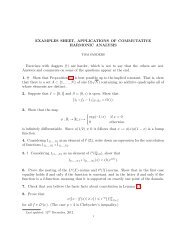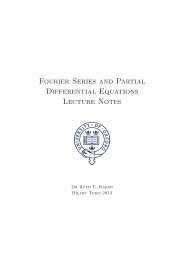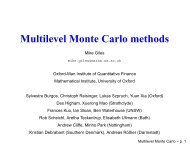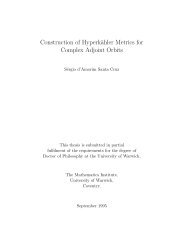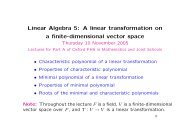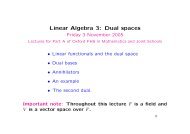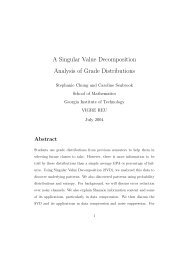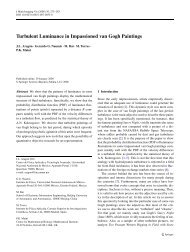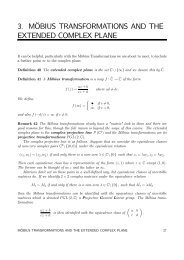Chapter 8. Chebyshev spectral methods
Chapter 8. Chebyshev spectral methods
Chapter 8. Chebyshev spectral methods
Create successful ePaper yourself
Turn your PDF publications into a flip-book with our unique Google optimized e-Paper software.
<strong>8.</strong>6. SOME REVIEW PROBLEMS TREFETHEN 1994 298<br />
formula in t. For N =32, k =0:01 is a su ciently small time step to ensure<br />
time-stability.<br />
(l) The ODE initial-value problem u t = f(ut)=cos 2 u, u(0) = 1, 0 t 100, is<br />
well-posed.<br />
(m) In exact arithmetic and with exact starting values, the numerical approximations<br />
computed by the linear multistep formula<br />
v n+3 = 1 3 (vn+2 +v n+1 +v n )+ 2 3 k(f n+2 +f n+1 +f n )<br />
are guaranteed to converge to the unique solution of a well-posed initial-value<br />
problem in the limit k ! 0.<br />
(n) If computers did not make rounding errors, wewould not need to study stability.<br />
(o) The solution at time t =1 to u t = u x +u xx (x 2 R, initial data u(x0) = f(x)) is<br />
the same as what you would get by rst di using the data f(x) according to the<br />
equation u t = u xx, then translating the result leftward by one unit according to<br />
the equation u t = u x.<br />
(p) The discrete Fourier transform of a three-dimensional periodic set of data on an<br />
N N N grid can be computed on a serial computer in O(N 3 logN) operations.<br />
(q) The addition of numerical dissipation may sometimes increase the stability limit<br />
of a nite di erence formula without a ecting the order of accuracy.<br />
(r) For a nondissipative semidiscrete nite-di erence model (i.e., discrete space but<br />
continuous time), phase velocity aswell as group velocity isawell-de ned quantity.<br />
0 = vn 4 is a stable left-hand boundary condition for use with the leap frog<br />
model of ut = ux with k=h =0:5.<br />
(s) v n+1<br />
(t) If a nite di erence model of a partial di erential equation is stable with k=h =<br />
0 for some 0 > 0, then it is stable with k=h = for any 0.<br />
(u) To solve the system of equations that results from a standard second-order<br />
discretization of Laplace's equation on an N N N grid in three dimensions<br />
by the obvious method of banded Gaussian elimination, without any clever<br />
tricks, requires (N 7 ) operations on a serial computer.<br />
(v) If u(xt) is a solution to u t = iu xx for x 2 R, then the 2-norm ku( t)k is independent<br />
oft.<br />
(w) In a method of lines discretization of a well-posed linear IVP, having the appropriate<br />
eigenvalues t in the appropriate stability region is su cient but not<br />
necessary for Lax-stability.<br />
(x) Suppose a signal that's band-limited to frequencies in the range [;40kHz 40kHz]<br />
is sampled 60,000 times a second, i.e., fast enough to resolve frequencies in the<br />
range [;30kHz30kHz]. Then although some aliasing will occur, the information<br />
in the range [;20kHz20kHz] remains uncorrupted.




